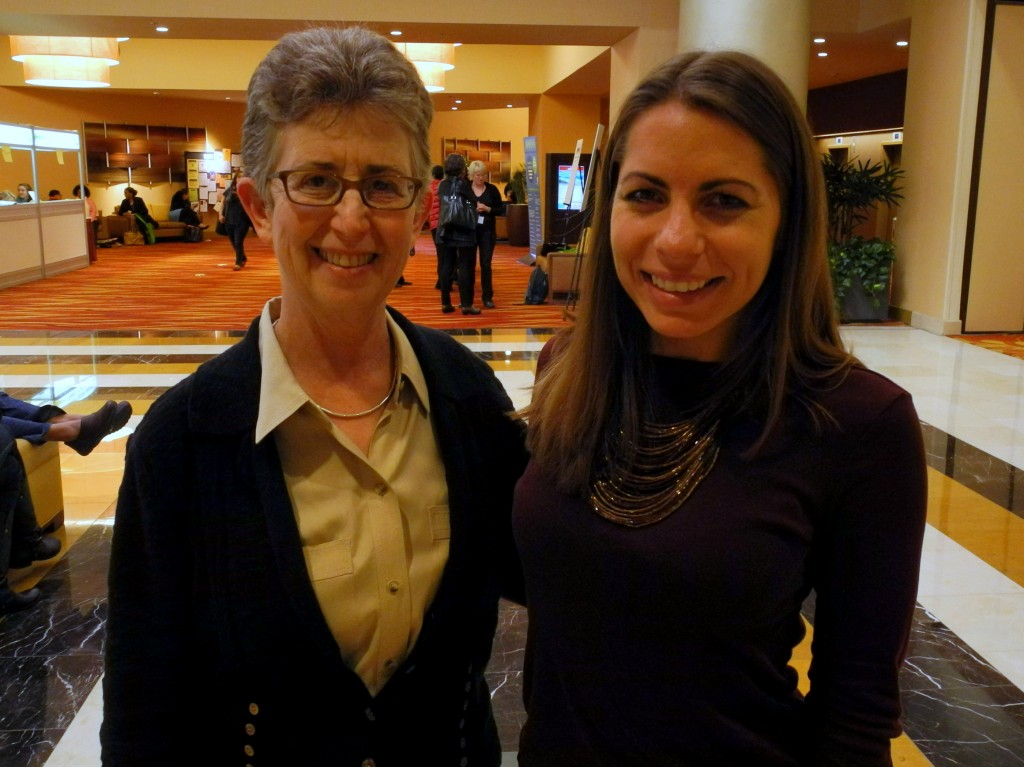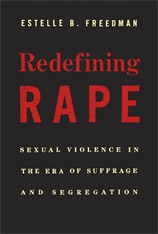
In college, I double majored in history and women’s and gender studies, and I also regularly faced street harassment when I left campus. I had no language to talk about it at the time and I often changed my life to try to avoid it.
Fast forward to present day, and as a history and women’s studies nerd and a street harassment activist, I was so thrilled to meet Stanford University Professor Estelle Freedman last year at the National Women’s Studies Association Conference and hear her presentation about street harassment in the 1880s to 1920s, based on a chapter in a forthcoming book.
That book is now out, Redefining Rape: Sexual Violence in the Era of Suffrage and Segregation (Harvard Press). While I bought her book because of the street harassment chapter, I read it cover-to-cover and literally underlined and made margin notes on every page.
In approachable language, she examines women’s (and their male allies’) efforts to strengthen laws against rape, marital rape, and incest, and the parallel and intersecting movements by persons of color (and their white allies) to gain more legal rights and end lynching. I highly recommend her book if you’re interested in ending sexual violence, seeing racial equality, and if you care about social justice in general.
She graciously agreed to a phone interview to discuss the mashers chapter, and that is found in Part 2. First, I want to share the overall themes of her book and their lessons for today.
Book Themes:
White men fear losing power:
A core theme of her book is white men’s fear of losing power, be that sexual power or political power. There were white men who openly fought against the passage of stronger rape and incest laws and laws that raised the age of consent. They used their position as the primary lawmakers, judges, and jury members to make decisions that best served their interests, and used their roles as journalists, newspaper owners, physicians and scholars to try to sway public opinion toward maintaining their rights at the expense of all women and all persons of color. White men were even faster to prosecute men of color for same-sex relationships than they were white men, allowing white men who had same-sex relationships (consensual or non-consensual) to rarely face consequences, even in states where those sex acts were illegal.
As one way to keep sexual power, some white men portrayed women and children (of both sexes) as unreliable, seductive, and sexually promiscuous. They also used “scientific” arguments similar to today for dismissing rape claims. For example, in 1862, Dr. Edmund Arnold testified in court that it was very improbable that pregnancy could result from rape because in “truly forcible violations…the uterine organs cannot well be in a condition favorable to impregnation.” In 1913, Dr. Gurney Williams wrote that if women just crossed their knees, they would be able to prevent rape.
Racial justice and sexual violence are connected:
Another major book theme was how racial justice and sexual violence are intertwined. For a long time, white men wrote laws in such a way that in some states, women of color could not legally be raped; they were seen as always sexually available. This made life extremely unsafe for them, especially in public places where white (and sometimes black) men could harass them and attack them and rarely face any consequences. Similarly, for decades, rape was called “The Negro Crime,” and classifying African American men as the rapists of white women gave white people the justification for lynching them and restricting their legal rights. Tactics for fighting lynching included showing that African American men were not sexual predators, and strategies for improving rape laws meant making sure women (and men) of all races were protected.
Lessons for Today:
Today, the legacy of racial injustices live on: women of color experience higher rates of sexual violence than white women and many men of color are falsely locked up for sex crimes they did not commit. The legacy of victim-blaming sexual assault survivors and debates over “legitimate rape” also sadly continues on.
The two most important lessons I took away are that we need:
1. Racial Allies. Throughout Redefining Rape, white women rarely addressed the sexual violence black women faced, especially at the hands of white men, nor did many of them join forces with African Americans to increase their legal rights or stop lynching. This sadly continues today. Most white people think racism isn’t a problem and so they don’t work to address it (and obviously many of us are perpetrators of racism), even within the feminist movement. The #solidarityisforwhitewomen hashtag on Twitter a few weeks ago made this clear. It was an online discussion led by women of color that called out white women for ignoring and silencing of women of color’s voices and issues within the feminist movement. This is something I’m personally working on as a white ally.
Racism and sexism and sexual violence are all intertwined. Those who are most marginalized and impacted need to have their voices heard; their experiences matter the most if we truly want to strive for equality.
2. Non-White Male Leaders: It is imperative to have more women of all races and men of color in leadership roles and positions of power. Until that happens, white men’s views, interests, and rights will continue to take precedent over everyone else’s, even if it is in lesser ways than 100 or 200 years ago. It will be hard to eradicate racism, sexual violence, street harassment, and victim-blaming until our leaders truly reflect all people, not just one segment of the population.
As Dr. Freedman conducted the research for her book, she kept coming across the term “mashers” and when she looked into it more, she realized these were street harassers. There were so many references to them during this time period that she devoted a whole chapter to the subject. Read my interview with her in Part 2.
DRAWING:
 Dr. Freedman donated a copy of her book (value $35) for me to give away in a drawing! Because of the cost of shipping the heavy book internationally, I am limiting this to people with U.S. addresses.
Dr. Freedman donated a copy of her book (value $35) for me to give away in a drawing! Because of the cost of shipping the heavy book internationally, I am limiting this to people with U.S. addresses.
There are two ways to enter your name into the random drawing, you can:
1. Tweet out an article or resource from the SSH blog and add @stopstharassmnt #Mashers to it.
2. Submit a street harassment story or street respect story to the blog (include an email address and note in the “other” field you want to be included in the drawing).
I will hold the drawing on October 18.
Read an excerpt of the book on Salon.com | Read an interview on the Hairpin. | Read a review in the SF Chronicles
